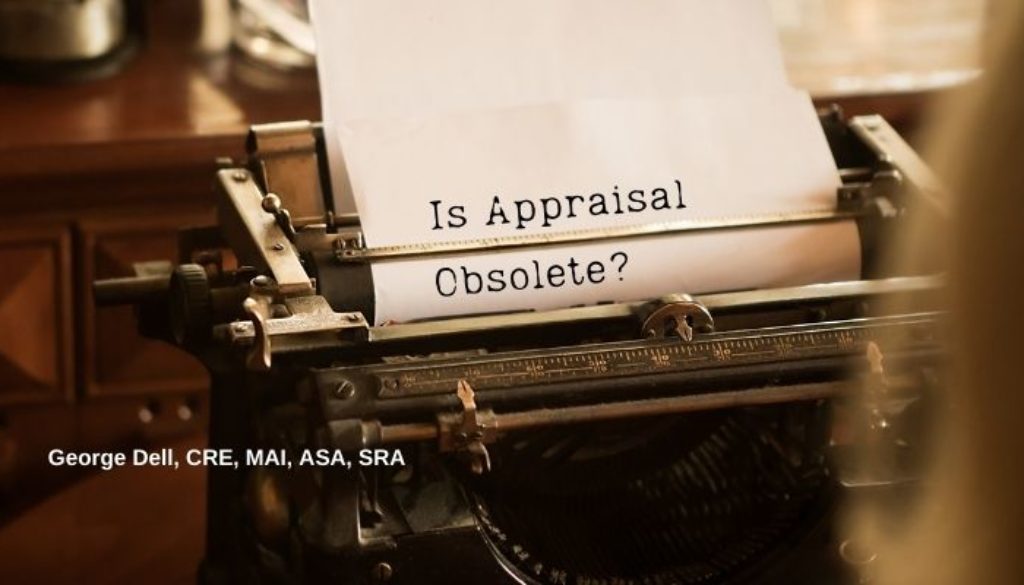Obsolete! Such a harsh word. Can it be?
Is the problem convolution?
Does it mean I will soon be obsolete? Not needed? Not loved? Terrible. What can be done?
Yet all the little signs are pointing that way. “Automated” valuation models have much of the market, and continue to gain. Other valuation methods and appraisal exempted transactions continue to grow. Evaluations, desktops, hybrids, auto-measurements, non-appraiser inspections, broker opinions.
The next seven weeks, the Analogue Blog will identify the five aspects of valuation: process, standards, education, client expectation, and regulation. We will end with the mystery solution.
Each of these five aspects has contributed to and ensures another failure of our economic system. Valuation, risk placement, and regulation each play upon the twin roles of misplaced capitalism and political contrivance.
The final solution blog will reveal a simple, direct solution. A solution of clear concept. But effective in its result. In single sweep, it outs obvious. A clean solution seeking recognition. A solution with a clear call to action, an assured result, and a secure success.
We will ask the question of each of the five forces of friction.
We will consider the impact on the three social impacts: consumers, taxpayers, and social justice.
We will review the economic issues of finance, housing, and equity.
To this end, we will consider the five aspects of valuation/risk, their component parts, and interrelationships.
Process: Current processes are controlled by the vagaries of each industry: appraisal by obsolete assumptions of data difficulty, automated models by industrial secrecy, and under-regulation or over-regulation depending on point of view of the particular method.
Yet the underlying valuation model/algorithms are essentially identical, regardless of the provider type:
- Problem definition and assumptions.
- Data selection, similarity elements.
- Predictor/adjustment algorithms.
- Delivery/summary conclusions.
Practices are embedded in habit, standards, expectation, and norms. Modern methods are resisted on several levels: personal, cultural, organizational, and regulatory.
Education is repetitive, rote, and ‘hours-based’ rather than effectiveness based. Modernized education is stymied by the extreme cost of innovation and application of modern education technology.
Regulation is convoluted. We have several federal agencies. Fifty-four state and territory systems. Application for a single 7-hour “approval” requires filling out around 120 different forms, and a ‘fees’ of around $7,000.
Expectation by users is similarly anchored to old methods. User decision-makers are themselves educated in traditional methods, or subject to complying with current bank audit policy and regulations.
Solution: This entire complex and convoluted system of control can be fixed. The solution is simple. It addresses the real issues. It serves the public trust. It serves each and every stakeholder in the system.
Is appraisal obsolete? In its current form it is. Yet the skills and competency of appraisers can be optimized with a single, technology-underlined shift.
In the next few issues of the Analogue Blog, we will explore each of the aspects holding back effective asset and risk assessment: process, standards, education, client expectation, and regulation. We will then present the needed paradigm shift — the simple solution.

December 1, 2021 @ 6:03 am
The question should be, are appraisers perceived to be obsolete? Fanniie and Freddie think so. First, remove the appraiser from the home because the appraisers inspection is not worthwhile. Reduce the appraisers role to an office job. Do not let the appraiser go to the neighborhoods because the expertise gained there is insignificant. Do not drive by the comps because that is insignificant. Let the real estate agents or the Groundworks employees do the inspection for $18 – $25(actual fees per Groundworks and agents) because they do a fine job. The appraiser will run off-the-shelf statistical software or self developed spreadsheet programs to help determine values. A couple of years later Fannie and Freddie will announce that the appraisers values are inferior because the programs they use and their interpretation of the data is inferior. The GSE’s will explain that their own software is far superior as are their analysts. So, as of 1-1-2026 appraisers are no longer needed.
December 2, 2021 @ 7:42 am
And the beat goes on